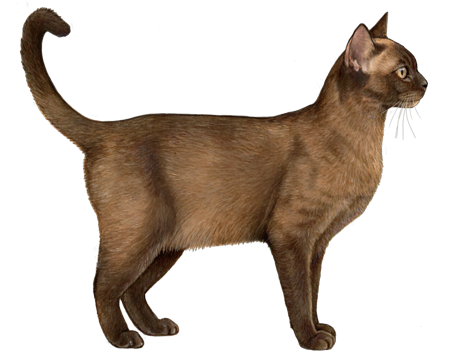
Toyger
Toygers pair the exotic appearance of a wild tiger with the personality of an easy-going domestic cat. They're confident, intelligent, and thrive on human companionship.
Interested in discovering if your cat is a Toyger?
Check out Wisdom Panel's DNA test.
Toyger Traits
General Appearance
Toygers are medium-sized cats with long, muscular bodies. Sleek and big-boned, they move with confidence and athleticism.
Coat and Colouring
The Toyger's beautiful coat is short but thick. The hair of the markings can be slightly longer than the hair of the body color. As with a tiger's coat, dark stripes provide a stark contrast to a bright orange background, and facial markings form a circular pattern. Gold glitter scattered over the top of the coat adds to the breed's dramatic appearance.
Distinctive Physical Traits
A Toyger's key features include a long, broad head, small rounded ears, small, circular eyes, robust body, and long, muscular tail.
Toyger Temperament
Toygers are friendly, laid-back cats that love spending time with their human families. They quickly adapt to most households and get along great with other pets.
Active by nature, Toygers need plenty of exercise. They enjoy playing, chasing, solving food puzzles, and participating in games of fetch. They're also an intelligent, outgoing breed that can learn to take leashed walks in the neighborhood.
Despite being energetic, Toygers are happy to curl up in a lap. And when they want affection from their people, they don't hesitate to vocalize their wishes. Because of their need for companionship, they may struggle if left alone for long periods.
Toyger History
In the 1980s, breeder Judy Sugden noticed one of her domestic tabbies had markings that resembled the circular patterns on a tiger's head. This inspired her to cross a striped domestic cat and a Bengal to create a new cat breed that looked like a miniature tiger but acted like a house cat.
Judy envisioned a long-bodied cat with a coat of bold, branched vertical stripes in a random pattern. Two other breeders—Anthony Hutcherson and Alice McKee—joined her. And over time, their efforts paid off.
In 1993, TICA accepted the Toyger (toy tiger) for registration and granted it Championship status in 2007.
Toyger Care
Nutrition
Toygers require a high-quality diet formulated for their current life stage (e.g., kitten, adult, senior).
Roughly one out of every three cats in the United States is overweight or obese. Since those extra pounds can contribute to other serious health issues, it's essential to keep your cat at a proper weight. To avoid overfeeding, measure out meals and reduce portions if necessary. And be sure to account for treats. As a guideline, they should make up no more than 10% of a cat's calories.
Lastly, all cats need access to fresh, clean water around the clock.
Grooming
Toygers are good self-groomers, so bathing is rarely necessary. A weekly once-over with a comb is typically all it takes to keep their coats clean and free of loose fur. But during periods of seasonal shedding, you may need to brush more frequently.
Ear cleaning and nail trims are also important parts of a comprehensive grooming routine. Check your cat's ears regularly for wax buildup or debris, and clip their claws monthly. Long nails are more likely to snag on something and become torn or damaged. They can even grow into your cat's paw pads, leading to pain or infection. In addition to clipping, providing a scratching post will allow your cat to do some nail maintenance themselves (thanks to their instinct to scratch).
And don't forget those teeth. Good dental hygiene is essential to a Toyger's lifelong health. Ideally, dental care should include daily at-home teeth brushing along with periodic exams and professional cleanings.
Health
Some breeds are more susceptible to certain health conditions. Toygers may be more prone to developing Hypertrophic Cardiomyopathy—which decreases the heart's efficiency and can lead to other issues. Consult your veterinarian if you're worried about this or other feline health disorders.
Breed Group
Asian
The Asian Group is comprised mainly of genetically similar breeds which vary widely in traits and personalities. These breeds are distinct from those of the Siamese and Oriental Group.
Resources
https://toygercatsociety.org/meet-the-toyger-2/
https://tica.org/breeds/browse-all-breeds?view=article&id=885:toyger-breed&catid=79
https://tica.org/phocadownload/tg.pdf
https://www.gccfcats.org/Cat-Breeds/Toyger
https://toygercatclub.co.uk/about-toygers/
https://www.banfield.com/state-of-pet-health/obesity
Reviewed 23 February 2021 by Jamie Freyer, DVM













